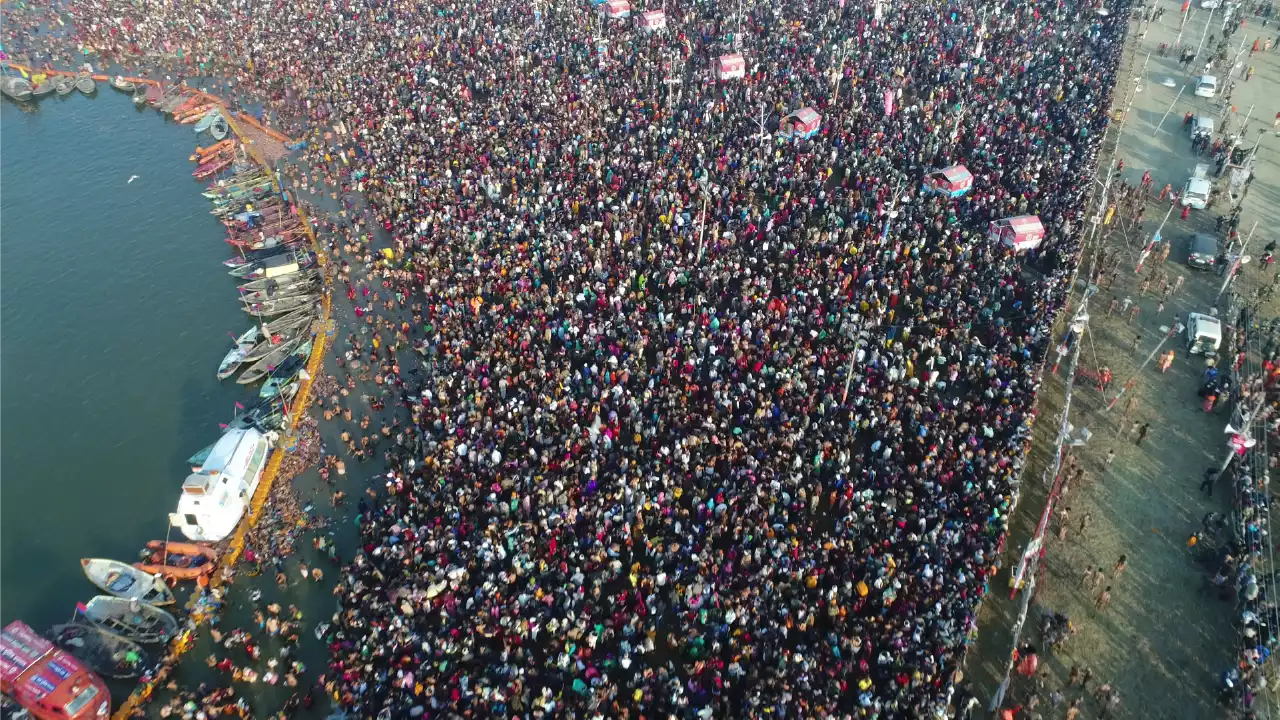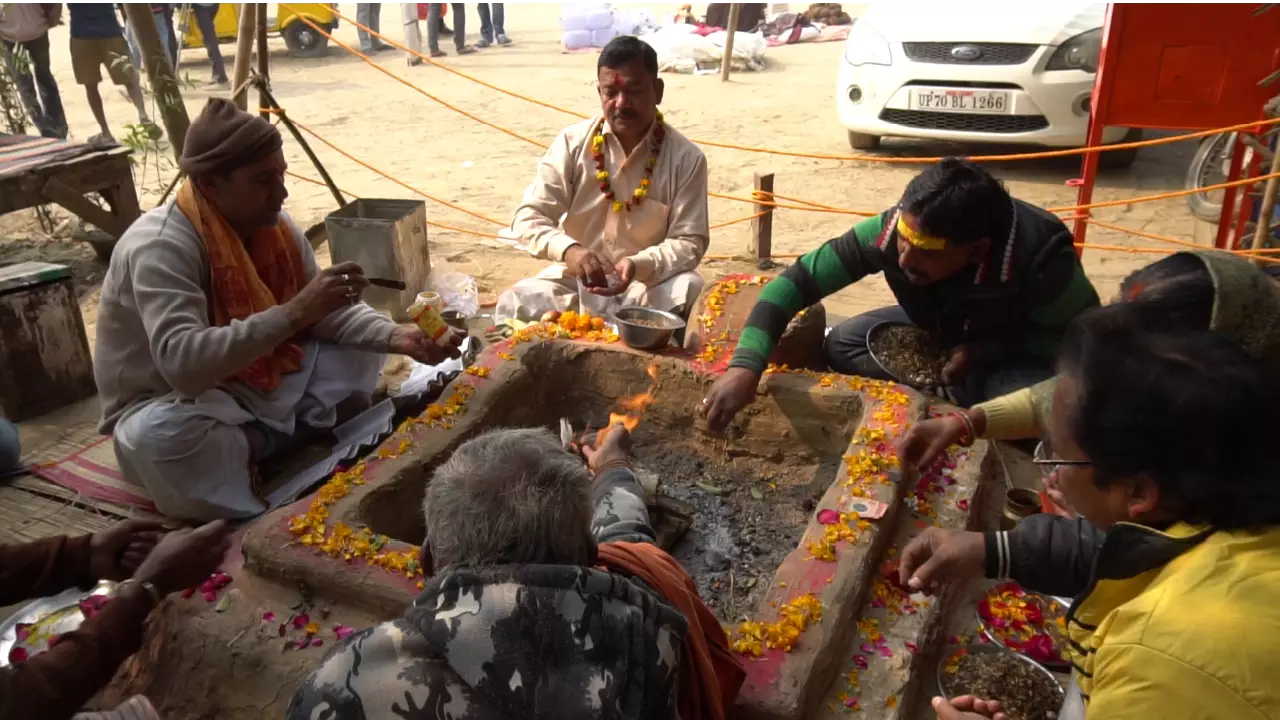Prayagraj Magh Mela 2026 Dates
Your detailed guide to Important dates of Magh Mela 2026
The Magh Mela is an ancient and deeply sacred annual gathering at Prayagraj, the King of all Teerthas. For seekers of spiritual merit, liberation, and blessings, knowing the Magh Mela 2026 Dates is the first step in planning a life-altering pilgrimage. The entire month of Magh is holy, but certain days hold immense power, when a dip in the holy Sangam can wash away the sins of a lifetime.
| Sacred Day (Snan) | Date in 2026 | Significance |
|---|---|---|
| Paush Purnima | Saturday, 3 January | The auspicious beginning of the bathing period and Kalpavas. |
| Makar Sankranti | Wednesday, 14 January | The first major Shahi Snan, marking the Sun's entry into Capricorn. |
| Mauni Amavasya | Sunday, 18 January | The most important bathing day, a day of silence and deep spiritual energy. |
| Vasant Panchami | Friday, 23 January | Celebrates the arrival of spring and is dedicated to Goddess Saraswati. |
| Maghi Purnima | Sunday, 1 February | Marks the culmination of the month-long Kalpavas austerity. |
| Maha Shivaratri | Sunday, 15 February | The final sacred bath of the Mela period, dedicated to Lord Shiva. |
The Sacred Land of Prayagraj

Why do millions gather here? Because Prayagraj is not merely a place; it is a divine space. Its very name comes from Pra (foremost) and Yag (sacrifice), signifying it as the foremost place of sacrifice, blessed by the Trimurti themselves.
Here, at the Triveni Sangam, the pale-yellow waters of Mother Ganga meet the serene blue-green Yamuna, joined by the mythical, invisible Saraswati. This confluence is the heart of all spiritual energy on earth. Our scriptures say that this holy ground is eternally guarded by the celestials and protected by Lord Vishnu. Its power is so great that while sins committed elsewhere can be washed away at other holy sites, Prayag has the power to absolve one from all consequences of sin, granting liberation to those who leave their mortal coil here.
The Auspicious Timing of the Magh Mela
The Magh Mela is an annual festival that takes place during the holy Hindu month of Magh (January-February). This period is not chosen by chance. The cosmos aligns in a special way to enhance the spiritual potency of this land.
The festival officially begins on Makar Sankranti, the sacred day when the Sun enters the zodiac of Capricorn (Makara Rashi). During this celestial transit, the Sun and Moon draw nearer to the Earth. Our sages have taught that at this time, their most beneficial and life-giving influences are showered upon all creation, and these energies are most profoundly absorbed by the waters of the Triveni Sangam. A holy dip during this period is not just a bath; it is an act of absorbing divine energy.
The Purpose of the Pilgrimage: Rituals and Practices

While many come to witness the spectacle, the true pilgrim comes to perform the sacred duties that purify the soul and bring peace to the ancestors. The central purpose is to take a purifying dip, or snan, in the Sangam.
The Holy Dip (Snan)
The primary reason millions gather is to bathe in the sacred waters. It is believed that a holy bath here during the Magh Mela washes away sins not just from this life, but from many past lives, helping the soul achieve moksha (salvation) from the cycle of rebirth. The meritorious reward of any charity, ancestral rite, or prayer performed at Prayag during this time is said to be undecaying and magnified a thousand times over.
One of the most profound practices observed during the Magh Mela is Kalpavas. The kalpavasis are devout souls who take a vow to live on the banks of the Ganga for the entire month of Magh. They live a life of extreme austerity in simple tents, renouncing all worldly comforts and desires. Their days are spent in a rigorous schedule of:
- Bathing three times a day in the icy waters of the Sangam.
- Performing prayers and rituals.
- Listening to spiritual discourses from saints and seers.
- Engaging in selfless service and contemplation.
Kalpavas is a period of deep introspection and penance, a commitment to purify the self and strive for an enlightened future.
Rites for the Ancestors (Shraddha and Pind Daan)
The banks of the Ganga at Prayag are one of the most powerful places on earth to perform ancestral rites. During the Magh Mela, thousands of families come to offer pinda (rice balls) and perform shraddha for their departed ancestors. It is believed that these rites, performed at this holy time and place, grant final liberation to the souls of the departed, satisfying them completely.
Other Sacred Practices
- Mundan Ceremony: For many families, the first ritual upon reaching the Sangam is the Mundan, or ritual tonsure (shaving of the head). This is an act of surrendering one’s ego and vanity (symbolized by hair) to the divine. The scriptures promise that for every hair sacrificed at the confluence, one is released from 10,000 rebirths.
- Worship and Satsang: Pilgrims spend their time performing pujas guided by the local priests, known as Prayagwals. The entire Mela ground echoes with the sound of chants, bells, and spiritual discourses (satsang), creating an atmosphere of unparalleled devotion.
A Tradition as Old as Time
The Magh Mela is not a recent festival. It is an “age-long” tradition with a recorded history stretching back for more than two millennia. The famed Chinese traveller Hiuen Tsang wrote a detailed account of witnessing a grand mela here in 643 A.D., attended by half a million people, including the great King Harshavardhana, who famously gave away all his wealth in charity.
This annual Magh Mela is the foundation for the even grander Kumbh Mela, which occurs at Prayagraj once every twelve years. During the Magh Mela, a vast temporary city of tents rises from the floodplain, complete with its own roads, electricity, and basic amenities—a spiritual metropolis that is built and dismantled every year. It is here that one can witness the living essence of Bharat, where people of all backgrounds mix freely with great saints and scholars, celebrating the eternal truth of unity in diversity.
To visit the Magh Mela is to step into a timeless current of faith. May your journey to Prayagraj on these holy Magh Mela 2026 Dates be blessed, and may the sacred waters of the Triveni Sangam purify your body, mind, and soul.
Hari Om Tat Sat.
